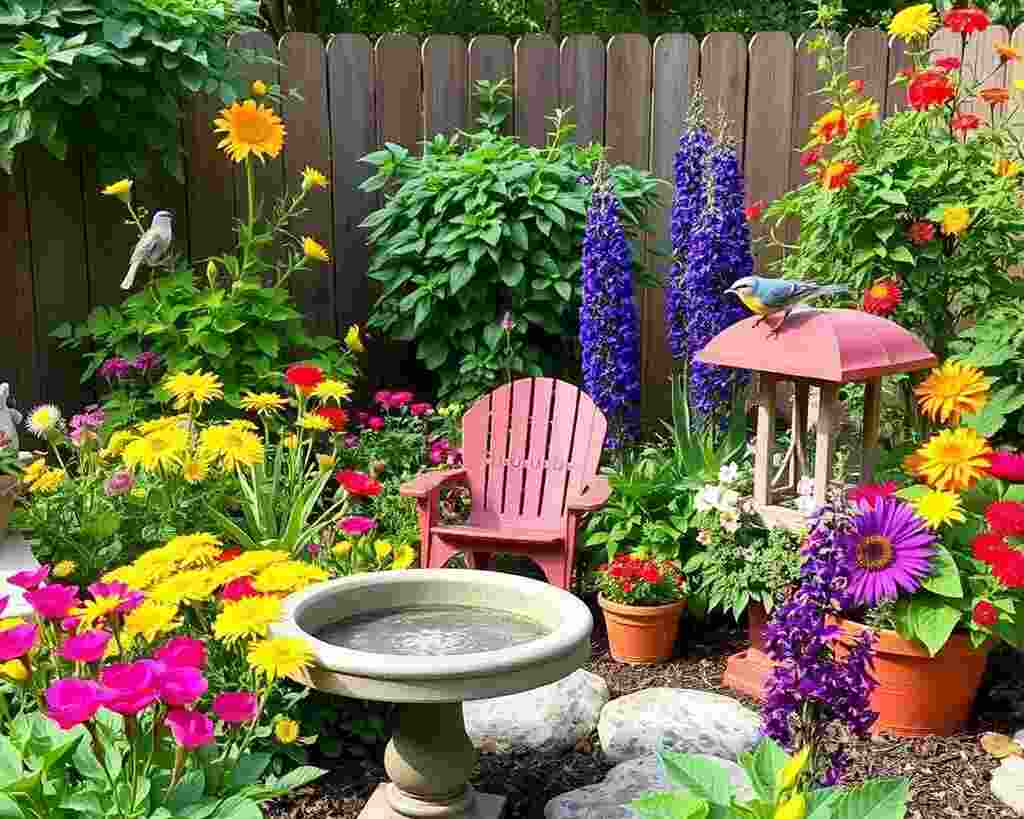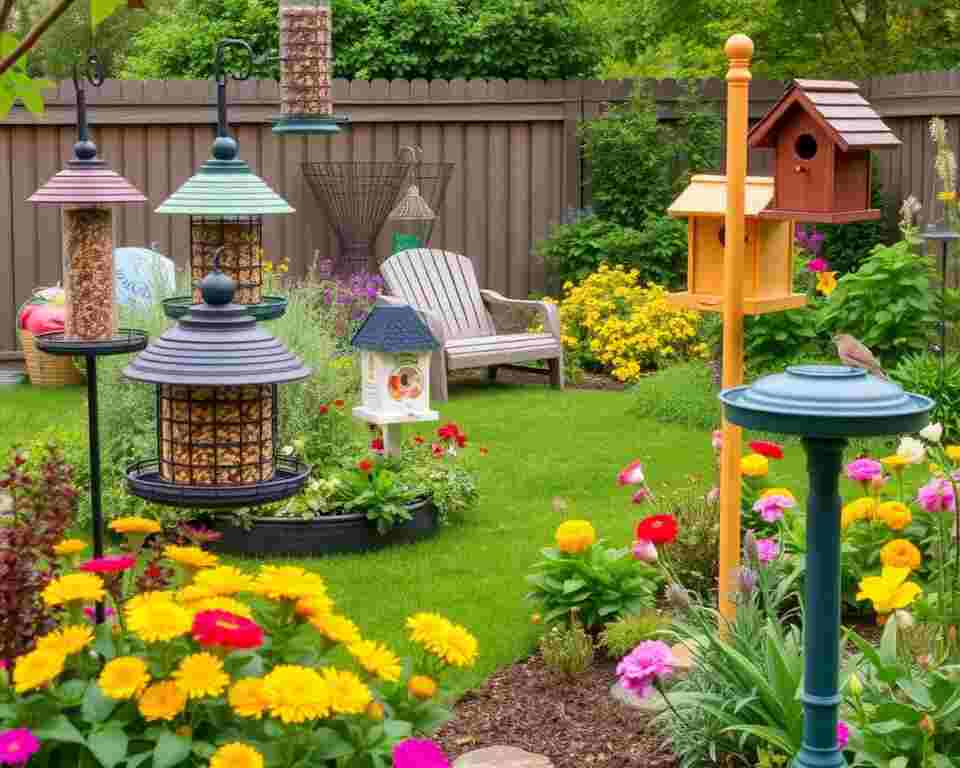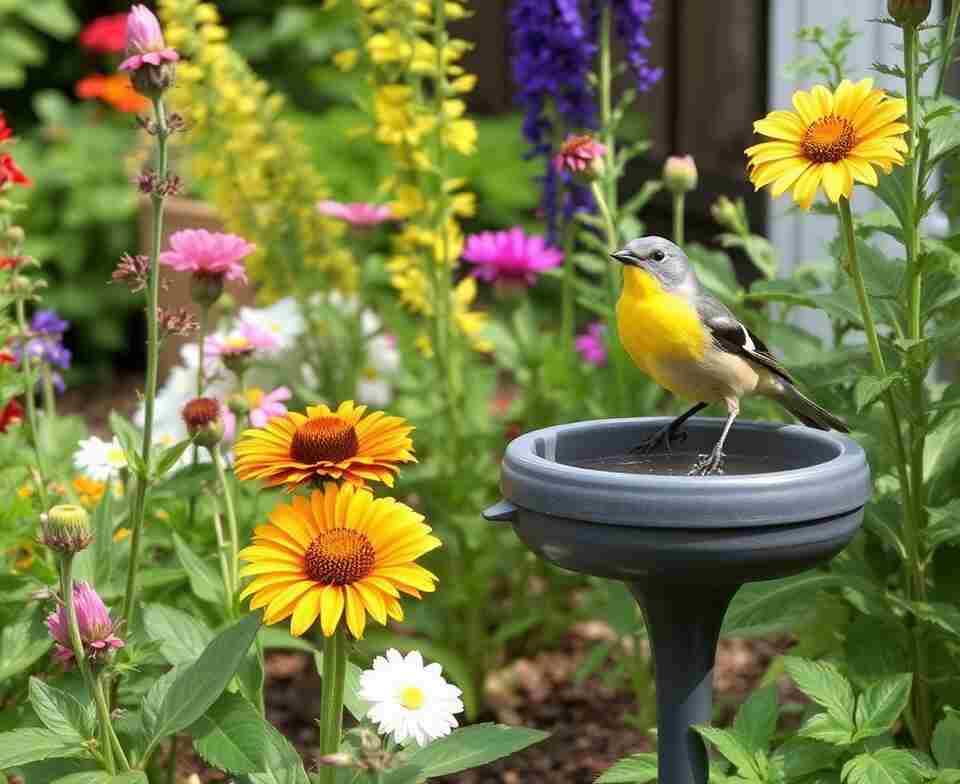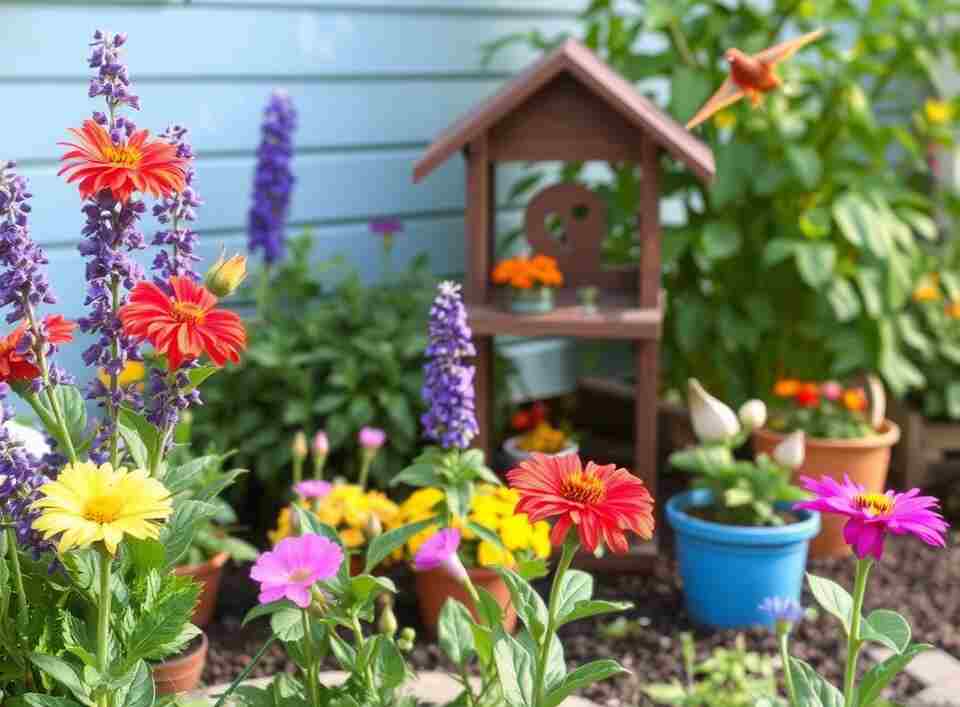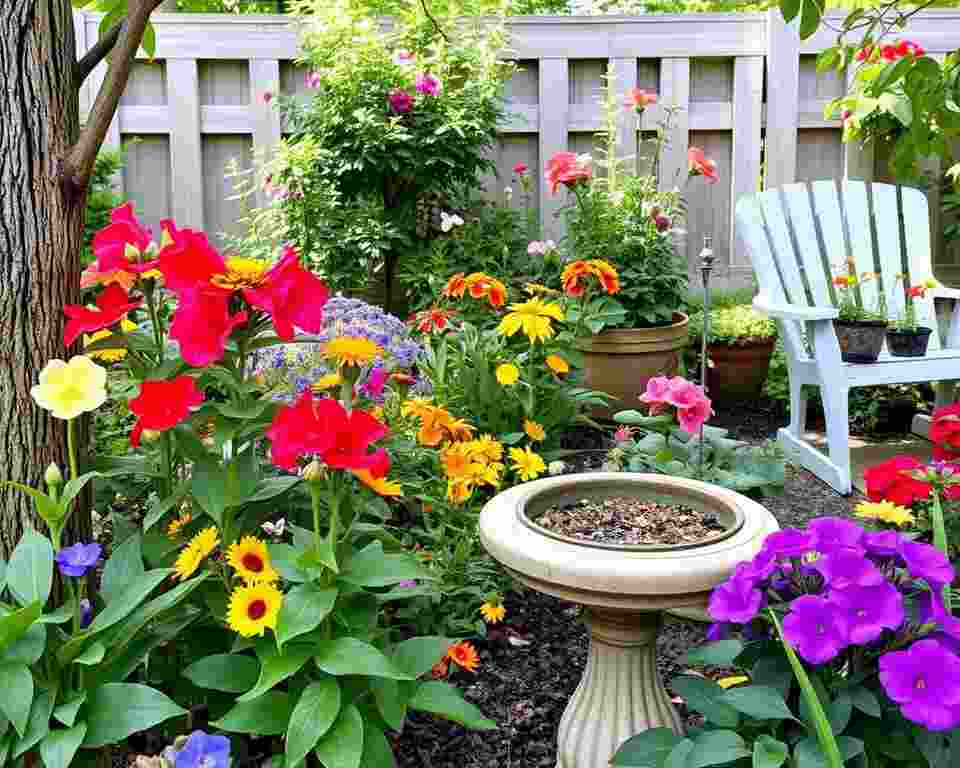Are you looking to transform your backyard into a haven for feathered friends? Whether you’re an avid birder or simply enjoy the melodious chirps and vibrant colors birds bring to your outdoor space, creating a bird-friendly backyard is a rewarding endeavor.
In this comprehensive guide, we’ll explore various strategies and tips to make your backyard more appealing to a diverse range of bird species. From providing essential resources to implementing bird-safe practices, you’ll learn everything you need to know to create your own backyard bird sanctuary.
Click the Play button below to listen to our podcast:
Table of Contents
- 1 Why Create a Bird-Friendly Backyard?
- 2 Essential Elements of a Bird-Friendly Backyard
- 3 Creating a Bird-Safe Environment
- 4 Landscaping for Birds: Creating a Bird-Friendly Habitat
- 5 Seasonal Considerations for Bird-Friendly Backyards
- 6 Bird-Friendly Backyard Features: A Comparison Table
- 7 Monitoring and Enjoying Your Bird-Friendly Backyard
- 8 Conclusion: Your Role in Bird Conservation
- 9 Author
Why Create a Bird-Friendly Backyard?
Before we dive into the how-to, let’s consider why making your backyard more bird-friendly is beneficial:
- Environmental impact: Supporting bird populations contributes to local ecosystem health. Birds play crucial roles in pollination, seed dispersal, and pest control.
- Personal enjoyment: Observing birds can be a source of relaxation and entertainment. The sights and sounds of birds can reduce stress and improve mental well-being.
- Educational opportunities: Bird-watching is an excellent way to learn about nature. It can be especially valuable for children, fostering an early appreciation for wildlife and conservation.
- Pest control: Many birds eat insects, providing natural pest management. This can reduce the need for chemical pesticides in your garden.
- Garden benefits: Birds can help with pollination and seed dispersal, contributing to a healthier and more diverse garden ecosystem.
- Conservation efforts: As natural habitats diminish, backyard sanctuaries become increasingly important for bird populations.
- Community engagement: A bird-friendly backyard can become a point of interest in your neighborhood, potentially inspiring others to create similar habitats.
Now that we understand the importance, let’s explore how to create an inviting space for our avian visitors.
Essential Elements of a Bird-Friendly Backyard
1. Food: The Foundation of Bird Attraction
Providing a variety of food sources is crucial for attracting diverse bird species to your backyard. Different birds have different dietary preferences, so offering a range of options will help you cater to a wider audience.
Natural Food Sources
Creating a backyard that provides natural food sources is the most sustainable way to feed birds. Consider planting:
- Berry-producing shrubs: Such as elderberry, serviceberry, or holly. These not only provide food but also shelter and nesting sites.
- Seed-bearing flowers: Like sunflowers, coneflowers, and black-eyed Susans. Let these stand through winter for continued food supply.
- Nut trees: If space allows, oak or beech trees can be excellent food sources. Even a single tree can significantly increase the biodiversity in your yard.
- Fruit trees: Apple, cherry, or mulberry trees can attract a variety of fruit-eating birds.
- Native grasses: Many birds feed on grass seeds, especially in winter.
When selecting plants, prioritize native species as they’re best adapted to your local climate and the needs of local birds.
Bird Feeders
While natural food sources are ideal, bird feeders can supplement these and attract a wider variety of species. Some popular types include:
- Tube feeders: Great for small seeds like sunflower or nyjer. These are favored by finches, chickadees, and titmice.
- Platform feeders: Suitable for a variety of seeds and accommodating larger birds like jays and doves.
- Suet feeders: Perfect for woodpeckers, nuthatches, and other insect-eating birds, especially in winter.
- Nectar feeders: Designed specifically for hummingbirds. In some regions, they may also attract orioles.
- Hopper feeders: These keep seed dry and are popular with many bird species.
- Peanut feeders: Attract woodpeckers, jays, and nuthatches.
Remember to keep your feeders clean and filled regularly to maintain bird interest and health. Clean feeders at least once every two weeks, more often in wet weather.
Types of Bird Food
Offering a variety of food types will attract different species:
- Black oil sunflower seeds: A favorite of many birds due to their high oil content and easy-to-crack shells.
- Nyjer seeds: Loved by goldfinches and pine siskins.
- Safflower seeds: Attractive to cardinals and grosbeaks, but less appealing to squirrels.
- Peanuts: High in protein and favored by woodpeckers, jays, and chickadees.
- Millet: Good for ground-feeding birds like sparrows and juncos.
- Suet: High-energy food, especially important in winter.
- Fruit: Oranges, apples, and grapes can attract orioles and tanagers.
- Mealworms: Live or dried, these are a high-protein treat for many birds.
2. Water: A Crucial Resource
Water is essential for birds, not just for drinking but also for bathing. Providing a reliable water source can significantly increase the attractiveness of your backyard to birds.
Bird Baths
A simple bird bath can be a powerful attractant. Consider these tips:
- Place the bath at ground level or elevated, but within sight of protective cover
- Ensure the water is no more than 1-2 inches deep
- Add a gentle slope or some stones for birds to stand on
- Keep the water fresh and clean, changing it every few days
- In winter, use a bird bath heater to prevent freezing
- Place the bath in a shaded area to keep water cooler in summer
Moving Water Features
Many birds are particularly attracted to the sound and sight of moving water. Consider adding:
- A small fountain or dripper to your bird bath
- A shallow, recirculating stream
- Misters, which are especially appealing to hummingbirds
- A small pond with a waterfall feature
The sound of moving water can attract birds from a considerable distance, making your yard a popular stop-off point.
3. Shelter: Safe Havens for Birds
Providing shelter is crucial for making birds feel secure in your backyard. This can come in many forms:
Natural Shelter
- Trees and shrubs: Dense foliage provides excellent cover from predators and harsh weather. Evergreens offer year-round shelter.
- Brush piles: Create a safe haven for ground-dwelling birds. Stack branches and twigs in a loose pile.
- Dead trees or snags: If safe, these can provide nesting sites for cavity-nesting birds and a food source for insect-eaters.
- Vine-covered walls or fences: These create vertical shelter and potential nesting sites.
Man-made Shelter
- Birdhouses: Different species prefer different types, so research what works best for birds in your area. Ensure proper sizing, ventilation, and drainage.
- Nesting shelves: Open-front structures for species like robins or phoebes.
- Roosting boxes: Provide warm shelter during cold nights. These are different from nesting boxes and are used primarily in winter.
- Brush tepees: Create a simple structure with branches leaned against each other.
4. Nesting Sites: Encouraging Breeding
To truly make your backyard a bird haven, provide suitable nesting sites:
- Leave dead tree limbs (if safe) for woodpeckers and other cavity-nesters
- Install birdhouses appropriate for local species
- Plant dense shrubs or trees for birds that nest in branches
- Provide nesting materials like pet fur, small twigs, or cotton fibers
- Create mud puddles for swallows and robins to use in nest construction
- Leave areas of tall grass unmowed for ground-nesting species
Remember to place nesting sites away from feeders to reduce competition and stress for nesting birds.
Creating a Bird-Safe Environment
While attracting birds is important, ensuring their safety in your backyard is equally crucial. Here are some ways to create a bird-safe environment:
1. Limit Pesticide Use
Pesticides can be harmful to birds both directly and indirectly. Consider these alternatives:
- Use natural pest control methods like companion planting
- Encourage beneficial insects that prey on garden pests
- If pesticides are necessary, use organic, bird-safe options
- Practice integrated pest management (IPM) to minimize chemical use
- Remove diseased plants promptly to prevent the spread of problems
For more information on the risks of glyphosate and its alternatives, read more here and here.
2. Prevent Window Collisions
Window collisions are a major cause of bird fatalities. Reduce this risk by:
- Applying window decals or films that break up reflections
- Installing external screens or netting
- Placing feeders either very close to windows (less than 3 feet) or far away (more than 30 feet)
- Using UV-reflective window stickers, which are visible to birds but not humans
- Closing blinds or curtains when possible to reduce reflections
3. Keep Cats Indoors
Domestic cats are one of the biggest threats to wild birds. If you have cats:
- Keep them indoors, especially during peak bird activity times
- If allowing outdoor time, use a catio or supervised leash walking
- Equip outdoor cats with a collar with a bell to warn birds
- Discourage feral cats from your yard using motion-activated sprinklers
4. Proper Feeder Placement
Strategic feeder placement can protect birds from predators:
- Place feeders near natural cover like shrubs or trees
- Avoid placing feeders in wide-open areas
- Consider using squirrel baffles to deter non-avian visitors
- Space multiple feeders apart to reduce competition
- Keep feeders at least 10 feet away from brushpiles to avoid creating an ambush spot for predators
5. Night-time Considerations
Artificial night lighting can disorient birds, especially during migration seasons:
- Use motion sensors for outdoor lighting
- Direct outdoor lights downward to reduce sky glow
- Use warm-colored LED bulbs instead of bright white or blue lights
- Close curtains at night to reduce light pollution from indoor sources
Landscaping for Birds: Creating a Bird-Friendly Habitat
The way you landscape your backyard can significantly impact its attractiveness to birds. Here are some bird-friendly landscaping tips:
1. Native Plants: The Bird-Friendly Choice
Native plants are adapted to your local climate and provide food and shelter that local bird species are accustomed to. Benefits of using native plants include:
- Providing familiar food sources
- Offering suitable nesting materials and sites
- Attracting insects that birds feed on
- Requiring less maintenance and water once established
- Supporting the entire local ecosystem, including other wildlife
Some popular native plants for birds (vary by region):
- Trees: Oak, Cherry, Dogwood, Maple, Birch
- Shrubs: Elderberry, Serviceberry, Viburnum, Bayberry, Chokeberry
- Flowers: Coneflower, Black-eyed Susan, Aster, Goldenrod, Bee Balm
- Vines: Virginia Creeper, Trumpet Honeysuckle, Native Wisteria
Research plants native to your specific region for the best results. Local native plant societies and extension offices can be excellent resources.
2. Layered Vegetation: Mimicking Natural Habitats
Creating a layered landscape mimics natural habitats and provides diverse resources for birds:
- Canopy layer: Tall trees for nesting and foraging. This layer provides a high vantage point for birds and can include both deciduous and evergreen species.
- Understory: Smaller trees and large shrubs for cover and food. This layer is crucial for many songbirds and provides excellent shelter.
- Shrub layer: Various shrubs for nesting and protection. Dense shrubs offer safe nesting sites and escape cover.
- Ground cover: Low-growing plants, leaf litter, and mulch for ground-feeding birds. This layer is important for sparrows, towhees, and other ground-foraging species.
- Vertical layer: Include vines and climbing plants to connect the layers and provide additional nesting sites.
3. Leave Some Mess: A Little Chaos is Good
While a manicured lawn might look nice to us, a slightly messy yard is more attractive to birds:
- Leave fallen leaves as ground cover. They harbor insects and provide foraging opportunities.
- Allow seed heads to remain on flowers through winter. These provide food for seed-eating birds.
- Create brush piles with fallen branches. These offer shelter and foraging sites.
- Leave some areas of your lawn unmowed. Taller grass provides cover and food for ground-feeding birds.
- Keep dead trees or limbs (if safe) as they provide homes for cavity-nesting birds and insects for food.
4. Reduce Lawn Area
Large expanses of lawn offer little value to most bird species. Consider:
- Expanding planting beds. Replace sections of lawn with native plant gardens.
- Creating wildflower meadows. These attract insects and provide seeds for birds.
- Installing water features or rock gardens. These add diversity to your landscape.
- Planting a diverse hedgerow instead of a fence. This provides food, shelter, and nesting sites.
5. Create Diverse Micro-habitats
Different bird species prefer different types of habitats. Try to include a variety:
- Woodland edge: A transition zone between open areas and denser plantings
- Thicket: A dense area of shrubs for cover and nesting
- Open area: A small clearing for ground-feeding birds
- Wetland: If possible, a small pond or rain garden can attract wetland species
Seasonal Considerations for Bird-Friendly Backyards
Different seasons bring different needs for birds. Here’s how to make your backyard bird-friendly year-round:
Spring
- Provide nesting materials like pet fur, small twigs, or cotton fibers
- Offer high-protein foods like mealworms for breeding birds
- Keep bird baths full and clean as activity increases
- Reduce yard maintenance to avoid disturbing nesting birds
- Plant nectar-rich flowers for returning hummingbirds and orioles
Summer
- Maintain water sources, especially during hot periods
- Continue offering seeds, but in smaller quantities as natural food is abundant
- Plant late-blooming flowers for hummingbirds and insect-eaters
- Provide calcium sources like crushed eggshells for birds raising young
- Keep some areas of lawn un-mowed to provide cover for fledglings
Fall
- Leave seed heads on flowers for migrating and resident birds
- Provide high-fat foods like sunflower seeds and suet as birds prepare for winter
- Keep leaf litter as a foraging area for ground-feeding birds
- Plant berry-producing shrubs and trees for fall and winter food
- Clean and repair birdhouses and feeders in preparation for winter
Winter
- Offer high-energy foods like black oil sunflower seeds and suet
- Provide unfrozen water sources, using heaters if necessary
- Leave winter berries and dried seed heads for cold-weather food
- Create windbreaks with evergreen plantings or brush piles
- Increase the number of feeders to reduce competition in harsh weather
Bird-Friendly Backyard Features: A Comparison Table
To help you prioritize your bird-friendly backyard improvements, here’s a comparison table of various features:
| Feature | Benefit | Difficulty to Implement | Maintenance Required | Effectiveness |
|---|---|---|---|---|
| Native Plant Garden | Provides food, shelter, and nesting sites | Medium | Low | High |
| Bird Feeders | Attracts a variety of species quickly | Low | Medium | High |
| Bird Bath | Provides essential water source | Low | Medium | High |
| Birdhouses | Offers nesting sites for cavity-nesters | Low | Low | Medium |
| Brush Pile | Creates shelter for ground-dwelling birds | Low | Low | Medium |
| Water Feature (e.g., fountain) | Attracts birds with moving water | Medium | Medium | High |
| Reducing Pesticide Use | Improves overall habitat health | Low | Low | High |
| Window Collision Prevention | Increases bird safety | Medium | Low | High |
| Keeping Cats Indoors | Protects birds from predation | Low | Low | High |
| Diverse Landscaping | Creates varied habitats for different species | High | Medium | High |
| Leaving Leaf Litter | Provides foraging opportunities | Low | Low | Medium |
| Providing Nesting Materials | Supports breeding birds | Low | Low | Medium |
| Installing a Birding Cam | Allows for detailed observation | Medium | Low | N/A (for enjoyment) |
Monitoring and Enjoying Your Bird-Friendly Backyard
Once you’ve implemented these bird-friendly features, the real enjoyment begins. Here are some ways to maximize your bird-watching experience:
1. Keep a Bird Journal
Document the species you see, when they appear, and their behaviors. This can help you understand patterns and adjust your backyard features accordingly. Consider noting:
- Date and time of sightings
- Weather conditions
- Bird behaviors (feeding, nesting, bathing, etc.)
- Any unusual occurrences or rare species
2. Participate in Citizen Science
Join projects like eBird or the Great Backyard Bird Count to contribute your observations to scientific research. These projects help researchers track bird populations and migration patterns. Other programs to consider:
3. Photography
Capture beautiful images of your backyard visitors. Even a smartphone can take great bird photos with practice. Tips for better bird photography:
- Use a tripod or stable surface for sharper images
- Take advantage of early morning or late afternoon light
- Be patient and let the birds come to you
- Learn about your camera’s settings for faster shutter speeds
4. Continual Learning
Use field guides or bird identification apps to learn more about the species visiting your yard. Some popular resources:
- The Merlin Bird ID app by Cornell Lab of Ornithology
- National Audubon Society Field Guide to Birds
- The Sibley Guide to Birds
- Online resources like AllAboutBirds.org
Invite friends and family to enjoy your bird-friendly backyard, spreading awareness about bird conservation. Consider:
- Hosting a backyard birding event
- Starting a neighborhood bird-watching club
- Sharing your photos and observations on social media
- Volunteering for local nature centers or Audubon chapters
6. Seasonal Observations
Pay attention to how bird activity in your yard changes with the seasons:
- Spring: Watch for returning migrants and nesting behaviors
- Summer: Observe parent birds feeding their young
- Fall: Notice flocks gathering for migration
- Winter: See how resident birds adapt to cold weather
7. Beyond Birds
While focusing on birds, also appreciate the other wildlife your bird-friendly yard attracts:
- Butterflies and other pollinators
- Small mammals like squirrels and chipmunks
- Beneficial insects that support the ecosystem
8. Continuous Improvement
Use your observations to continually enhance your bird-friendly backyard:
- Experiment with different types of feeders or food
- Adjust plant selections based on bird preferences
- Improve water features if certain types seem more popular
Conclusion: Your Role in Bird Conservation
Creating a bird-friendly backyard is more than just a hobby—it’s a valuable contribution to bird conservation. As natural habitats continue to diminish due to human development, our backyards can serve as crucial sanctuaries for many bird species.
By providing food, water, shelter, and safe nesting sites, you’re not only attracting beautiful and interesting visitors to your yard, but you’re also supporting local and migratory bird populations. Your efforts can make a real difference in helping birds thrive in an increasingly challenging environment.
Remember, creating a bird-friendly backyard is an ongoing process. Continue to observe, learn, and adjust your approach based on the needs of your avian visitors. With time and attention, your backyard can become a vibrant hub of bird activity, providing you with endless opportunities for enjoyment and connection with nature.
Your bird-friendly backyard can also serve as an inspiration and educational tool for your community. By sharing your knowledge and experiences, you can encourage others to create their own bird sanctuaries, amplifying the positive impact on local bird populations.
As you embark on this rewarding journey, remember that every small action counts. Whether it’s planting a native shrub, putting up a birdhouse, or simply leaving a small area of your yard a bit wild, each step you take makes your backyard more welcoming to birds.
So, start implementing these bird-friendly practices today, and watch as your backyard transforms into a bustling avian paradise. Your feathered friends—and the local ecosystem—will thank you for it!
Images created using PicLumen. Visit www.piclumen.com for more.

